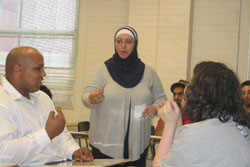The sweeping array of language offerings reflects the diversity on campus

Would you rather parler français or sprechen Deutsch? The answer comes wrapped around a surprising number of variables, all of which help determine which foreign tongues Rutgers students opt to learn, and which constitute the “hottest” languages in any given academic year.
Prevailing geopolitical and economic winds, a family’s ethnic background, even a beloved professor in high school – all play into a student’s choice, say professors in Rutgers’ language departments.
Rutgers School of Arts and Sciences has eight departments with responsibility for instruction in foreign languages: Amesall (African, Middle Eastern and South Asian Languages and Literatures); Asian Language and Cultures; Classics; French; GREELL (Germanic, Russian, and Eastern European Language); Italian; Jewish Studies; and Spanish and Portuguese.
The sweeping array of language reflects the diversity on campus, many of the academics note.
“One big factor in choosing a language is the role of the family and pride in one’s origins, coupled with the desire to learn more of the language of your heritage,” says James Swenson, humanities dean in the School of Arts and Sciences. “A second large factor is concern for knowing a language that will set students up for future employment, but also there’s a significant amount of simple intellectual curiosity that drives language selection as well.”
In the last decade, Swenson notes, undergraduates and graduates have flooded Asian language classes. Together, Chinese, Japanese, and Korean represent the biggest draw in all of the university’s language departments. The trend reflects not only the financial ascendance of the East, but also the large number of Asian students who call New Jersey home, Rutgers language scholars say.
“Japanese used to be the most attractive of our languages for business majors, but now Chinese draws just as much attention, with many of our students in Chinese coming from business or economics-related majors,” says Richard VanNess Simmons, professor of Asian language and cultures.
“In general, there seems to be a steady growth in interest in Chinese since the late 1990s, although that slowed after the SARS scare 10 years ago. But things rebounded quickly, and, especially since the Beijing Olympics in 2008, enrollment has remained steady over the past few years, and is more than double what it was 15 years ago.”
That same year, Rutgers wove together more than a dozen languages to create the department that has come to be known as AMESALL, whose offerings include Arabic, Persian, Turkish, Hindi, Bengali, Sanskrit, Urdu, Swahili, and Zulu. Twi, the language of Ghana and Surinam, was recently added, reflecting the strength of the Ghanaian diaspora in the region.
“Arabic is definitely the most significant numerically, followed by Hindi,” says the department’s Alamin Mazrui. “Certainly, heritage plays a large part, but we’re also seeing students who want to pursue careers in education, diplomacy, international business, and working with developmental agencies.”
Increasingly, he adds, non-heritage students realize that in a world in which Africa, Asia, and the Middle East have become important economic and political partners, acquiring one or more of their languages helps meet the challenges of the job market.
Meanwhile, more and more students are concluding that you don’t have to be Jewish to study Hebrew, says Orly Moshenberg, Hebrew-language coordinator in the Department of Jewish Studies. Although the number of students has remained stable over the past decade, the composition of the classes has changed.
“Our 100-level classes now include students from a diverse cultural background,” she says. “We have students from the Middle East, and it seems the numbers are increasing. We also have students who come from Indian, Chinese, and Korean backgrounds. It is possible that those students take Hebrew to enrich their career choice, such as international law, business, and medicine.
An influx of Russian-born Jews and Israeli immigrants to New Jersey has also driven up enrollment, Moshenberg says.
“Geopolitical and economic events – such as the fall of the Berlin Wall – do tend to spur interest in foreign languages,” says Martha B. Helfer, chair of Germanic, Russian, and Eastern European Languages, noting that German, Russian and Polish are among the most sought-after courses in her department this year.

“In recent years, my department has developed vibrant summer programs in Berlin and St. Petersburg,” Helfer says. Moreover, she adds, students frequently study German or Russian to complement coursework in other disciplines, such as philosophy, history, art history, political science, business, and comparative literature.
Meanwhile, French, Spanish and Italian continue to lure their share of devotees.
With more than 175 million French speakers in the world and with France claiming distinction as the No. 1 tourist destination, the language of Voltaire and Maupassant retains its hold on students’ imaginations, says Carole Allamand, associate professor and chair of the French Department.
“Students are surprised to learn that French is a good language if you want to go into business,” the academic says, citing the 2,800 French companies located in the United States and France’s ranking as the world’s fifth-largest economy.
Although interest in the language dipped post-9/11 as Francophobia gripped the country, enrollment has recovered in the past few years, Allamand notes – driven in part, she believes, by the 60,000 to 80,000 French-speaking Haitians who have emigrated to New Jersey.
Meanwhile, the Department of Italian, one of the largest programs in the United States, attracts more than 1,300 students every year, says department chair Alessandro Vettori.
"Italian Americans are the largest ethnic constituency in New Jersey, with one-third of the state's population or 1.3 million residents identifying with their Italian heritage," notes Vettori, who adds that Rutgers offers one of only 19 doctoral programs in the country -- and the only one in the Garden State.
As for Spanish, interest has been mounting steadily over the past two decades, says Celines Villalba, who doesn’t foresee a change in the near future.
The Spanish-language coordinator notes that enrollment by heritage speakers has been on the upswing since the 1980s, with others opting to study Spanish as a portal to careers in medicine, business, science, and banking.
“Being bilingual definitely gives them better opportunities in terms of salary and job markets,” Villalba says.